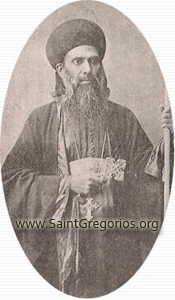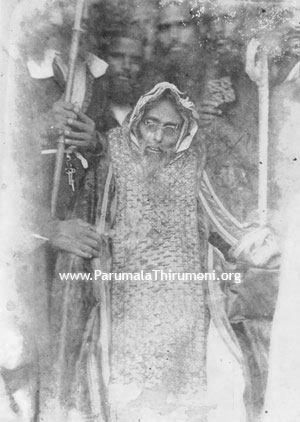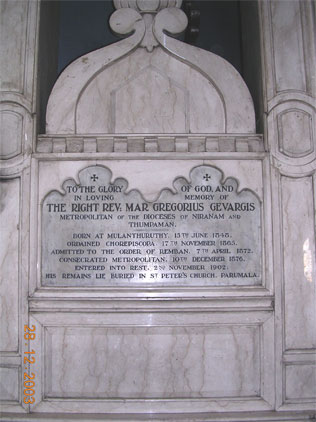![]()
St. Gregorios Geevarghese, popularly
known as "PARUMALA THIRUMENI" was born in the distinguished priestly
family of 'Pallathattu Thanagattu'
in the village of Mulunthuruthy near Cochin, India on 15th June 1848.
He was baptized by name Geevarghese (George) at the
Mulanthuruthy Mar Thoman Church.
Geevarghese’s mother died when he was a small boy and since then he
was under the loving care of his elder sister Mariam.
From
childhood days he followed a very disciplined
life which was
enriched by prayer and fasting. 'Kochaipora'
as he was known in
those days, had a deep fascination towards Syriac, the liturgical language
of the Syriac Orthodox Church. His extraordinary ability to sing Syriac
hymns beautifully & perfectly came to the notice
of his uncle (father's brother) Malpan Kassisso Geevarghese who was an
authority in Syriac and a celibate priest. Impressed by his nephews'
extraordinary divine qualities Kassisso Geevarghese gave
proper guidance to him. The other two personalities who had greatly influenced young Geevarghese were Malpan Kassisso Geevarghese Konattu (later
Geevarghese Mor Julius) and
St. Yuyakkim Mor Koorilos
Bava, the Syrian Metropolitan who was the Reesh
Episcopa to Malankara. The later years the Malankara church was witnessing
the emergence of a great monk who through continuous prayers, made it clear
to the world that Prayer and
devotion is mightier than any worldly possession. The Holy Father's short life was
remarkable in many respects. A deacon at the age of 10, a priest at the age of
18, a bishop at the young age of 28 (the reason for calling him 'Kochu
Thirumeni'); he passed away at the age of 54 on
2
nd November 1902, after a saintly life of prayer to
become the brightest jewel of the Universal Syrian Church.
disciplined
life which was
enriched by prayer and fasting. 'Kochaipora'
as he was known in
those days, had a deep fascination towards Syriac, the liturgical language
of the Syriac Orthodox Church. His extraordinary ability to sing Syriac
hymns beautifully & perfectly came to the notice
of his uncle (father's brother) Malpan Kassisso Geevarghese who was an
authority in Syriac and a celibate priest. Impressed by his nephews'
extraordinary divine qualities Kassisso Geevarghese gave
proper guidance to him. The other two personalities who had greatly influenced young Geevarghese were Malpan Kassisso Geevarghese Konattu (later
Geevarghese Mor Julius) and
St. Yuyakkim Mor Koorilos
Bava, the Syrian Metropolitan who was the Reesh
Episcopa to Malankara. The later years the Malankara church was witnessing
the emergence of a great monk who through continuous prayers, made it clear
to the world that Prayer and
devotion is mightier than any worldly possession. The Holy Father's short life was
remarkable in many respects. A deacon at the age of 10, a priest at the age of
18, a bishop at the young age of 28 (the reason for calling him 'Kochu
Thirumeni'); he passed away at the age of 54 on
2
nd November 1902, after a saintly life of prayer to
become the brightest jewel of the Universal Syrian Church.
A brief life-history
St. Gregorios was blessed with the order of Korooyo at the tender age of ten by Palakunnath Mathews Mor Athanasius at the Karingachira St. George Jacobite Syrian Church. At the age of 18, he was ordained Shamshono by Yuyakim Mor Koorilos, the Reesh Episcopa to Malankara (Patriarchal delegate). The very next month Shamshono Geevarghese was ordained a Kassisso (full priest) and later Corepiscopa, again at the blessed hands of Yuyakim Mor Koorilos Bava. Later he settled at the Vettickal dayro near Mulunthuruthy where he led a very strict monastic life. In 1872 he was professed a Ramban (Monk-Priest) by Mor Dionysius V Pulikottil.
Those were the days when the protestant missionary activities, aided by the British Government, was at its heights. These missionary groups and their supporters created all sort of hardships for the Syrian Church and its hierarchy. The patriarchal delegates were deported from the states of Travancore and Kochi. The Indian metropolitans were not allowed to enter the churches. Priests who opposed these missionaries were arrested and jailed (Church history by E M Philip). Many Syrian Christian churches were either taken over or closed by the government. To bring an end to this extraordinary situation the faithful in Malankara came together under the leadership of Ramban Geevarghese Chathuruthy and organised a general body of Malankara Church on 8th September 1873 at Parumala which seek the help of the church supreme, the Patriarch of Antioch, then residing at the monastery of Deir ez-Za`faran (Kurkumo dayro) in Turkey.
Accordingly His Holiness Ignatius Peter IV (also referred as 'Pathros III' in many Malankara records), the Patriarch of the Apostolic See of Antioch & All the East and the Supreme pontiff of the Universal Syrian Orthodox Church, arrived in Malankara in June 1875. Ramban Geevarghese who was well versed in Syriac was appointed as the interpreter to the Patriarch. The Patriarch greatly impressed with the young Ramban, chose him also as his private secretary. When the historic Mulunthuruthy Synod was convened in the month of June 1876, the assistance of Ramban Geevarghese was of much help to His Holiness. The Patriarch's esteem of the Ramban grew so high that His Holiness decided to elevate him to the order of Metropolitan.
On 10th December 1876, H.H. the Patriarch ordained Ramban Geevarghese a Metropolitan by name 'GREGORIOS' at the North Paravur St. Thomas church. When in Malankara, His Holiness the Patriarch had consecrated six Metropolitans of which Mor Gregorios was the youngest and was only 28 and hence he came to be known by the endearing name KOCHU THIRUMENI. The ancestral house where Mor Gregorios was born and brought up was known by name 'CHATHURUTHY' and for that reason he is also often referred to as CHATHURUTHY THIRUMENI.
After the departure of the Patriarch in 1877, at the behest of our Kochu Thirumeni, all the newly ordained Metropolitans observed a 40 day fasting staying at the Vettickal dayro before assuming the responsibilities of their respective dioceses. In his bishopric, he established various churches and was the motivator to establish schools in different parts of Malankara. Mor Gregorios was a man who grasped the value of Education for the overall progress of the Church as well as the society in general. In late 1890's, many educational institutions were started by the Malankara Jacobite Syrian Church under the initiative and guidance of Parumala Kochu Thirumeni and Malankara Metropolitan Pulikottil Joseph Mor Dionysius. The St. Thomas School at Mulanthuruthy, St. Ignatius School at Kunnamkulam (named after his mentor the Patriarch Pathros IV (III), the Syrian English School at Thiruvalla (now known as 'MGM High School'), etc., were some of the well known schools established at the behest of Parumala Thirumeni.
The saintly father was closely and intimately associated with varied activities and development of the Malankara Jacobite Syrian Church. He was very much admired for his organizing ability and was very popular with the masses. Following the demise of the respective Metropolitans of Thumpamon and Kollam dioceses (in 1884 and 1891), the administration of these dioceses also fell under him. In 1887, the first block of the Parumala Seminary was opened and in January 1895, just before his historic visit to Jerusalem, he along with Malankara Metropolitan Mor Dionysius V Pulikottil consecrated the St. Peter's church (seminary church) at Parumala.
While staying at Parumala Seminary, Mor Gregorios taught Syriac to deacons. His ability to tack Syriac hymns was exceptional, a talent he developed through his close association with the Syrian Metropolitan St. Yuyakim Mor Koorilos. Even in the midst of all the busy schedules he gave utmost priority to prayers and fasting. He used to get up at 4 am for prayer and strictly followed the church practise of prayers seven times a day. Observing all the Church Lents, including the fasting on Wednesdays and Fridays was a regular affair from his child-hood days. Mor Gregorios was very keen in maintaining relationship with all section of people, irrespective of caste or community. He always showed love and cared for the poor and suffering. He was very particular for the truthfulness and helping the poor. His Grace took special interest in preaching the Holy Gospel of Our Lord among the backward communities and many were accepted into our fold. He also worked hard to uplift this marginalized people.
His Grace's long standing desire to visit the Holy Land was fulfilled in 1895, nineteen years after his ordination as Metropolitan. During his pilgrimage, he stayed at the "Sehion Malika" (Monastery of St. Mark) which was the diocesan headquarters of the Syrian Orthodox Metropolitan. During his stay there, H.G. visited almost all the important places of Christendom and led the Passion Week services at the altars of our Syrian Church in the Holy City. On his return, His Grace collected a certain amount from all the Parishes in Malankara and sent a Silver Cross as offering to the Holy church in Jerusalem.
At the age of 54 Thirumeni became seriously sick. He knew that his end was near. While the Metropolitans and priests and others were praying, Kochu Thirumeni uttered, "MY LORD" and closed his eyes. Kochu Thirumeni passed away on Monday, the 3rd November, 1902 and his mortal remains were laid to rest the next day (4th November) at the St. Peter's Church, Parumala. (In many forums the day of his demise is wrongly mentioned as November 2nd, 1902 which is incorrect)
 |
 |
First major organization in the name of St. Gregorios of Parumala (Mor Gregorios students movement)
The Church in Malankara had formed a "Syrian Students Conference" in 1907 for the proper guidance of its youth. However the rifts that surfaced in the Malankara Syrian community from 1911 onwards and the subsequent events created problems for the smooth functioning of this Students congregation. About a decade after, the Malankara Jacobite Syrian Church under the leadership of its Malankara Metropolitan decided to rejuvenate the Students movement. Accordingly on 6th May 1922, a Students session of the Church was convened at the Cheruthottukunnel St. George church of Angamali diocese under the guidance of Malankara Metropolitan H.E. Paulose Mor Athanasius (Valiya Thirumeni), who was incidentally one of the most trusted and prominent disciples of St. Gregorios Chathuruthy. The congregation assembled there, under the suggestion of Mor Athanasius, named its students movement as "MAR GREGORIOS YAKKOBAYA VIDHYARTHU SANGAM" (Mor Gregorios Jacobite Syrian Students Association-MGJSSA). This is the first ever students organization in Malankara that adopted the name St. Gregorios of Parumala. Meanwhile the Malankara Orthodox Church (Metropolitan sect) also reorganised their students wing in the name, 'St. Thomas Syrian Students Movement'. Both these students organizations of respective churches were functioning in parallel till 1960's when both the students movements merged to form a single unit following the reunification of both the Churches, and was thereon came to be called the Mar Gregorios Orthodox Christian Students Movement (MGOCSM). A decade later the reunified Church again parted following which the Jacobite Syrian Church went back to their old name for their students organization. Thus the first Students movement started in the name of St. Gregorios Chathurthil of Parumala came to be known as the Mor Gregorios Jacobite Students Movement (M.G.J.S.M).
Conferring sainthood / Remembering MOR GREGORIOS in the 5th TUBDEN (Holy Diptych)
On 22nd August 1987, the Holy Episcopal Synod of Malankara Jacobite Syrian Church presided over by the late lamented Catholicos of the East Aboon Mor Baselios Paulose II, made requests before the Church's spiritual head the Patriarch, to permit the name of Mor Gregorios to be recited in the 5th 'TUBDEN' along with the monks and martyrs of the Holy Church.
Consequent to this request, His Holiness the Patriarch Ignatius Zakka-I Iwas issued the historical Bull dated 20th December 1987, authorizing the recital of the name of MOR GREGORIOS of Malankara in the Fifth 'TUBDEN' (diptych) in all the Malankara churches worldwide. This Bull was first read in the home parish of our holy father at the Mulanthuruthy Mar Thoman Church. The name of the Holy father henceforth is recited in the 5th TUBDEN, after the names of late Patriarch of Antioch Moran Mor Ignatius Elias III (Manjinikkara, 1932) and Maphryono Mor Baselios Yeldho (Kothamangalam, 1685) whose names were also included together with that of St. Gregorios. Concerned Encyclical of the Patriarch of Antioch permitting to recite the name of St. Gregorios in the Tubden
. About a decade later, the Malankara Orthodox Church which declared the holy father, a saint, years back, also started to recite the name of Mor Gregorios in the TUBDEN.
The holy relics of St. Gregorios is now interred in many churches. A large number of churches are built in the holy father's name all over the world. Perhaps the churches and shrines built by the Malankara Syrian Christians in recent times, named after ST. GREGORIOS, are the largest in number, next only to those which bear the names of Mother Mary and Geevarghese Sahdo.